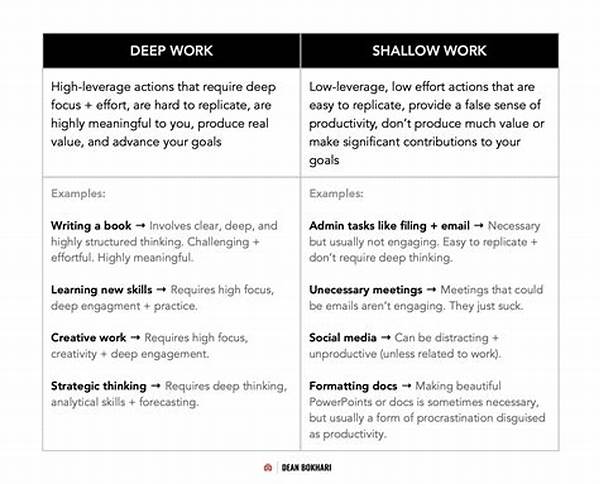In the bustling world of modern business and creativity, our minds are constantly challenged to differentiate between deep work and shallow work. These two types of work are omnipresent in every professional’s life and understanding their differences can significantly enhance productivity and satisfaction. Deep work, a term popularized by productivity expert Cal Newport, refers to professional activities carried out in a state of distraction-free concentration that push your cognitive capabilities to their limit. This type of work creates new value, improves your skill set, and is hard to replicate. On the other hand, shallow work consists of non-cognitively demanding, logistical-style tasks, often performed while distracted. These tasks are not typically valuable nor do they enhance one’s cognitive abilities.
Read More : Simple Hacks To Stay In Deep Work Longer
Picture a world where you can achieve more by doing less, where focused, uninterrupted thinking leads you to groundbreaking insights and unparalleled successes. This is a world where deep work reigns. It is the distinction between spending hours crafting an innovative marketing strategy versus responding to emails all day. It’s the clarity in writing a detailed novel chapter as opposed to skimming through article headlines. In this fast-paced age, deep work is the secret weapon that can separate the good from the great and the successful from the average. Meanwhile, shallow work pulls you into the quicksand of endless busyness without meaningful progress.
Embracing deep work allows professionals to carve out blocks of uninterrupted time to delve deep into their most critical tasks, fostering creativity and skill enhancement. In contrast, shallow work, while necessary to some degree, often consumes much of the workday without yielding substantial progress toward long-term goals. By recognizing and strategically scheduling both types of work in their daily lives, individuals can maximize their productivity and satisfaction.
In this article, we will delve into various deep work vs shallow work examples, examining how understanding these concepts can refine one’s workflow and lead to remarkable achievements. Stay tuned as we explore how you can transform your productivity game through a balanced approach to deep and shallow work.
The Benefits of Deep Work
Harnessing the power of deep work means attaining a level of focus often unavailable in today’s distraction-filled environments. Unlike shallow work, deep work offers the benefit of skill development, a substantial increase in output quality, and a significant boost in efficiency. Renowned authors, top executives, and industry leaders frequently attribute their success to setting aside dedicated time each day to immerse themselves in deep work. This approach not only fosters creativity but also leads to more fulfilling accomplishments.
—
In the realm of productivity, understanding the differences and applications of deep work and shallow work is essential for achieving peak performance. Picture this: you walk into your office, ready to dive into a major project. The challenging task ahead demands your undivided attention and creativity. This is deep work, where interruptions are the enemy, and focus leads to breakthroughs. Conversely, shallow work may occupy your time with efforts like sorting emails and coordinating meetings—necessary but far less impactful.
Deep work is characterized by sessions of concentrated effort. Think of a software developer crafting intricate code that revolutionizes an application, or a researcher analyzing data to uncover groundbreaking conclusions. These tasks create high value and require intense focus. On the contrary, shallow work might involve organizing files or updating spreadsheets; tasks that, while necessary, don’t manifest new insights or push the boundaries of your abilities.
The Essence of Deep Work vs Shallow Work
The core difference between these two lies in quality versus quantity. Deep work demands depth, resulting in innovation and skill mastery. It’s an opportunity to tap into a state of flow where time dissipates, productivity heightens, and impressive work is born. Shallow work, however, revolves around maintenance tasks that keep the daily grind moving but rarely yield profound achievements.
Honing your ability to engage in deep work while balancing the inevitable shallow tasks can redefine your success in any field. By identifying peak focus times, creating environments conducive to concentration, and reducing distractions, individuals can allocate more effective periods to deep work, leading to a transformative impact both personally and professionally.
Mastering Your Time for Deep and Shallow Work Tasks
To gain a true competitive edge, mastering the interplay of deep work and shallow work tasks is paramount. Recognizing that both are integral to professional life, the key lies in crafting a comprehensive strategy that paves the way for maximal efficiency. Prioritizing deep work at times of high energy ensures significant outputs, while dedicating periods of lower energy to shallow work maintains momentum in daily operations.
—
Uncover the potential within your routine by grasping these deep work vs shallow work examples. The subtle shift in acknowledging which activities propel you further versus those essential for maintenance can revolutionize your productivity and professional satisfaction.
Crafting a Balanced Daily Routine
Integrating deep work into your daily routine begins with an honest evaluation of your tasks. By defining which actions have the most impact, you can align your schedule to elevate those that are truly transformative. Use breaks to address shallow tasks, ensuring the overall flow continues, without detracting from your core, meaningful work. Create pockets of uninterrupted focus to foster creativity and growth. This equilibrium not only enhances productivity but provides a sustainable path to achieving long-term ambitions.
Developing a Deep Work Ritual
Embrace routine and consistency by developing a ritual that suits your work style. Whether it’s the morning calm or the evening quiet, choosing a time that aligns with your natural peak productivity fosters a deep work ethos. Eliminate distractions, set clear goals for each session, and immerse yourself wholly in the task at hand. By embedding these principles into everyday habits, deep work transitions from a goal to a natural aspect of your life, propelling you towards greater achievements.


